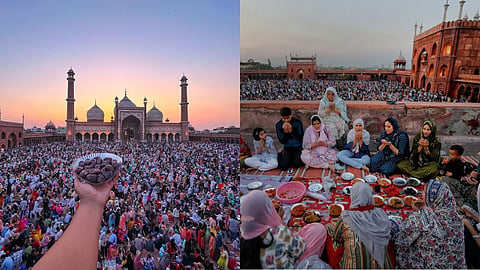
- HOMEGROWN WORLD
- #HGCREATORS
- #HGEXPLORE
- #HGVOICES
- #HGSHOP
- CAREERS
- ABOUT US
- CONTACT US

The narrow lanes of Old Delhi are filled with the smoky scent of kebabs carried by the spring breeze, and as the sun sets on the horizon, you'll experience a sensory and spiritual journey that begins with Iftar during a Ramadan evening. The streets of Old Delhi, home to a large Muslim population, embody a mindful and intentional atmosphere throughout the day, but come alive at sunset when the Roza (fast) is broken, and the place becomes bustling with activity.
Ramadan is a holy month on the Islamic calendar and is observed by 1.9 billion Muslims across the world. Its significance lies in the belief that the first verses of the Quran were revealed to Prophet Muhammad during this time. Muslims fast from sunrise to sunset for 30 days during Ramadan; it's a time for them to delve into a spiritual cleanse, reflect, act with intention and gratitude, while breaking away from any habits that don’t serve them. While a Ramadan evening is metaphysical in its sentiment, we will be exploring the physical experience of visiting Old Delhi during this time, which can be a transformative experience that allows you to connect with a rich cultural and religious tradition.
Iftar
There are several ways people break their fasts for Iftar, one of which is attending a community Iftar at Jama Masjid. As the second largest mosque in India, Jama Masjid attracts people of all faiths and backgrounds, alongside fasting Muslims, to gather in its courtyard to observe the sunset and break their fast. Traditionally, people break their fasts with water and khajoor (dates) at the onset of dusk and then move onto eating a hearty meal. The Masjid also encourages almsgiving, an essential Islamic practice, and visitors often are seen sharing Iftar platters with those in need, while some organise a mass dining spread.
Matia Mahal, located next to Jama Masjid, is another spot that is perfect for Iftar, with its bustling food joints scattered along the lane. Many people choose to break their fasts with Old Delhi’s famous Mohabbat-e-Sharbat: a refreshing drink made with Rooh Afza, watermelon, milk and basil seeds. Visitors also flock to Al Jawahar, a Mughlai restaurant famous for its tender mutton nihari, flavourful mutton korma, biryani, and khameeri roti. Aslam Chicken Corner is another crowd favourite for its mouth-watering kebabs and special preparation of the widely loved butter chicken, which is served with a dollop of ghee and roomali roti. A hearty meal for Iftar is best followed by palette cleansing dessert, and in this case it's Haji Nadeem’s sheermal. Sheermal is a baked flatbread that is made with milk, flour, sugar, ghee and saffron. For those with an even sweeter-tooth, Cool Point’s revered shahi tukda is a rich treat to indulge in.
Taraweeh
After iftar, the winding streets and alleys of Old Delhi remain lively as many Muslims head to mosques to attend Maghrib, the evening prayer, and go on to spend quality time with their loved ones. Another common practice during this time is to visit the nearby dargahs — holy shrines dedicated to Sufi saints, which are beautifully decorated with colourful flowers and bright lights. Here, people offer prayers and often stay for Qawwalis, a genre of devotional music that is performed during the holy month.
As the night deepens, it's time for Taraweeh, a special congregational prayer that takes place every night during Ramadan. Taraweeh is considered to be a serene and peaceful experience, as Muslims get to reflect and relax while making dua, asking for forgiveness and spiritual guidance from Allah. During the month of Ramadan, community and connection are emphasised, and Taraweeh prayers give Muslims the opportunity to grow and strengthen their bond with each other and with Allah.
Sehri
Before the crack of dawn arrives, people prepare for the next day with Sehri, which is a crucial meal for fasting Muslims to keep hunger at bay. Sehri is a filling meal eaten in the early hours, before the first prayer of the day, to provide adequate energy to those observing fasts. Old Delhi’s renowned Karim’s restaurant is a popular Mughlai destination for Sehri. During Ramadan, they offer a special menu that includes their famous Keema Kaleji, which is a minced meat and liver curry, biryani, slow cooked Mutton nihari, and naan. Other popular spot for Sehri is Haji Mohd and Hussain Chicken & Fish Fry, which serves fried chicken and fish that can rival global fried chicken chains. After the meal, Sehri is then wrapped up by drinking water and performing Fajr, the first prayer of the day.
The month of Ramadan spells out a powerful and spiritual time for Muslims, and as it nears its end, the excitement for Eid-al-Fitr builds. In Old Delhi, the celebration of Eid is a lively affair, with people coming together to pray, eat special food, and break their fasts with loved ones. The spirit of Eid also inspires acts of charity, as giving alms and donations is an important tenet of Islam, highlighting the values of generosity and kindness. The vibrant festivities and gatherings in Old Delhi during Eid reflect the deep sense of community and unity that lies at the heart of this special occasion.
If you enjoyed reading this, here's more from Homegrown:
Exploring Muslim Culture & Identity In Contemporary India With Author Rakhshanda Jalil
Mehdi Saajid's Art Depicts The Varied Nuances Of Diversity, Culture, & Heritage
Rationing For Ramadan: 12 Mumbai Restaurant Meals You Should Break Your Fast With
